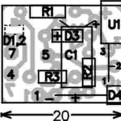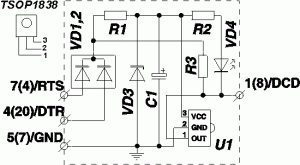The irdroid serial cable Kit , is a inexpensive serial (RS-232) device that allows you to capture IR remotes data. The Serial cable kit does not have any decoding logic. All the infrared signal decoding is performed via the irrecord application , which is part of the LIRC project. In the Gallery below the schematics, and the pcb layout files of the Irdroid serial IR cable kit are provided.
The following is required to build the kit:
- Soldering Iron
- FTP flexible cable or any other cable with 6 wires
- DB9 RS-232 connector
- Irdroid serial IR cable kit PCB
- Irdroid serial IR cable kit schematics
- Irdroid serial IR cable kit assembled unit
The Kit contains the following components:
| 1. | PCB 0217 | – 1 pcs. |
| 2. U1 |
IR Receiver TSOP1838 |
|
| SFH5110-38 or PNA4612M | – 1 pcs. | |
| 3. VD1,2 | Diode double BAY70 SMD | – 1 pcs. |
| 4. VD3 | Zener diode 5,1V | – 1 pcs. |
| 5. VD4 | LED F3 |
– 1 pcs. |
| 6. С1 | capacitor 22µF/6,3V | – 1 pcs.. |
| 7. R1 | resistor 910 (820)Ω | – 1 pcs. |
| 8. R2 | resistor 1,8 (2,2)kΩ | – 1 pcs. |
| 9. R3 | resistor 4,7 (3,3)kΩ | – 1 pcs. |
| 10. | Enclosure Canon DB 9 / front plate | – 1 pcs. |
The Serial Ir receiver is to be connected to a unused RS-232 (serial) port of your computer and it is power supplied from the serial port. For this purpose the lines RTS and DTR are used. The Signal lines RTS and DTR are established in a level “0” state, this level (in the RS-232 standard) corresponds to a voltage of +10 volts. The Zener diode VD3 limits this voltage to 5 volts, which is needed for the proper function of the infrared receiver IC. The Capacitor C1 has a filtering function. The Infrared receiver module U1 is a specialized IC, which amplifies the infrared signals and demodulates them. The carrier frequency between 30 and 50khz (most commonly used 38khz) is used. Depending on wheather there is a carrier frequency emitted or not, the output pin of U1 generates voltages which corespond to logical “0” and logical “1” . These bits are then transfered to the DCD line of the RS-232 and it is further decoded by the software installed in the PC. Most of the Software solutions that work with the infrared receiver module allows for choosing of the line which carries the data. In our case it is the DCD line.The cable lenght of the receiver should not be longer than 2 meters ( a limitation of the RS-232 ).
For information regarding the software used to capture IR codes please refer to this article:
https://irdroid.com/2013/02/recording-ir-remotes-using-inexpensive-ir-receiver-device/
You could purchase irdroid serial IR receiver from the DIY section below :
[print_thumbnail_slider]










